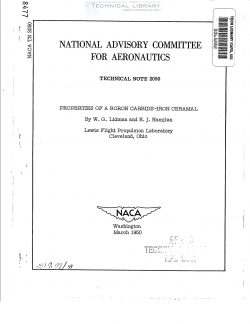naca-tn-2050
- Version
- 103 Downloads
- 1.30 MB File Size
- 1 File Count
- December 9, 2016 Create Date
- December 9, 2016 Last Updated
National Advisory Committee for Aeronautics, Technical Notes - Properties of a Born Carbide Iron Ceramal

An investigation was made to determine the properties of a
boron carbide-iron ceramal. These properties were compared. with
the properties of hot-pressed boron carbide. The properties eval-
uated were room- and elevated-temperature modulus of rupture,
resistance to fracture by thermal shock, density, and oxidation
characteristics. A study was also made of the microstructure of
the ceramal.
Microscopic examination showed the ceramal to be composed
of not less than two phases: boron carbide, and a solution or
chemical combination of iron and boron carbide. Ceramals con-
taining materials that form a bonding phase may possess desirable
strength properties at temperatures approaching the melting point
of the metal.
The hot-pressed boron carbide was superior to the ceramal in
modulus of rupture. A high percentage of the room-temperature
strength was retained by the ceramal at 26000 F, which was attrib-
uted to the high strength of the carbide network, strengthening of
the iron by combination with some of the boron carbide, or both.
The thermal-shock resistance of boron carbide was improved by the
addition of iron. At 15000 F, the resistance to oxidation of the
ceramal was better than that of the ceramic; although both mate-
rials oxidized rapidly at 2000° F, the ceramic was superior. The
poor oxidation resistance of the caramel indicated that a pro-
tective coating would be required for continued operation above
16000 F.
The boron carbide-iron camel has a low density (average
density 5.24 gin/ml), which gives it an additional advantage when
it is compared with metals or other ceramals on the basis of the
strength-density ratio.
Designers of flight-propulsion units are currently seeking
materials for use in the temperature range from 18000 to 24000 F.
Suitable materials must retain their strength in this range long
enough to permit reasonable overhaul periods and should be resist-
ant to oxidation and to fracture by thermal shock. Materials with
high strength-density ratio are desirable for use in rotating
parts. The alloys currently used. do not operate successfully
above 18000 F and it has become necessary to consider more refrac-
tory materials, such as ceramics.
| File | Action |
|---|---|
| naca-tn-2050 Properties of a Born Carbide Iron Ceramal.pdf | Download |

Comment On This Post